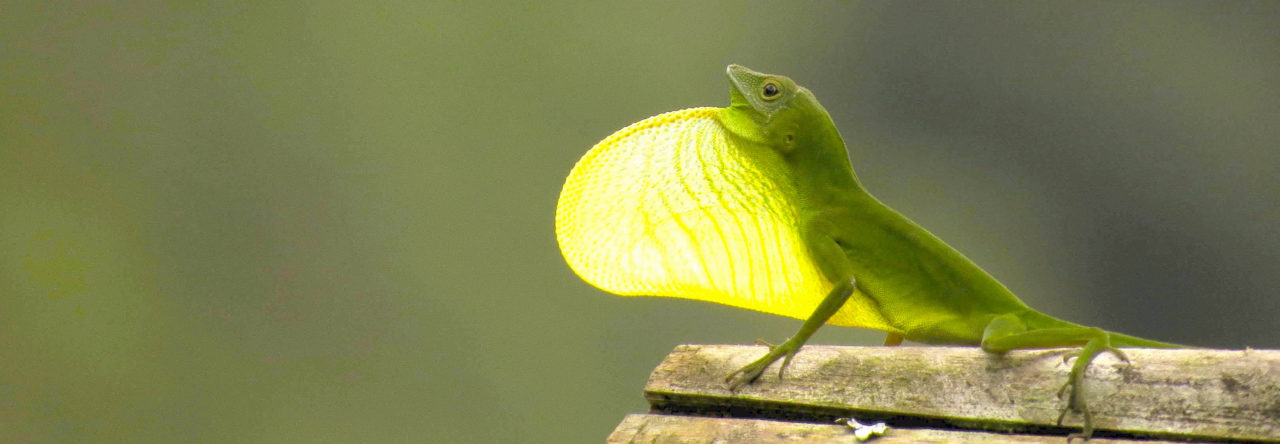The last leg of our Little Known Mainland Anole Tour took us to the mountains above Caracas, in quest of Anolis tigrinus. A “mystery anole” photo of that species was put up on AA in December, and savvy readers quickly pegged it as a mainland species, noting it’s twig anole-like appearance. Moreover, the only publication on the natural history of this species, by Ugueto, Rivas, Barros, and Smith, suggested it was a twig anole as well. Given our previous work that had identified the twig anolishness of A. proboscis in Ecuador and A. (Phenacosaurus) heterodermus in Colombia (earlier in this trip), we’re beginning to see a trend: twig anoles seem to be the one kind of West Indian ecomorph that has evolved many times on the mainland (the A. pentaprion clade is another candidate).
So, fresh from the beaches of Maracaibo, we headed to the mountains in quest of the tiger anole. A last minute change in plan led us to the little town of Colonia Tovar at about 7000 feet in elevation. We didn’t know what to expect from TC, but Wikipedia describes it as “Germany in the Caribbean.” Established by settlers from Baden (now part of Germany) in the 1850’s, the town gradually declined for a century, before reinventing itself as a kitschy tourist trap in the 1960s, and now it’s booming. And it was delightful. All of the buildings seemed straight out of Bavaria, there were brewhauses and wienerschnitzel (see photo at bottom of post), the waitresses wearing their fraulein get-ups.
We stayed at a delightful little hotel, Cabañas Heidelberg. And for no extra charge, we were able to go lizard hunting in the little patch of woods out back. Those of you who’ve hunted twig anoles know how hard they are to find: small, cautiously creeping, high up in the canopy, well camouflaged. I recount our adventures in my recent Scientist at Work post, but I’ll give the short story here: we found the first one three minutes into the afternoon’s field work, our second one a minute later, and they kept coming fast and furious all afternoon long. I’ve only seen something like that once—A. angusticeps on South Bimini—and even that wasn’t nearly the abundance of these twiggers.
And twiggers they were, being found on narrow vegetation, low and high. But we were in for a surprise—they weren’t creeping like twig anoles. Rather, they were sprinting and jumping and overall showing a behavioral exuberance that was exactly the opposite of what we’d seen in the very cautious, one-slow-step-at-a-time, behavior of A. proboscis and A. heterodermus and Caribbean twig anoles. Why? Got me, but they certainly were zipping around.
You might be wondering why the name tigrinus. Here’s the answer:
And, finally, one more view of life in Colonia Tovar:
- Evolution in Real Time on Lizard Island - March 23, 2025
- Spider Snags Adult Anolis osa - March 22, 2025
- An Homage to the Green Anoles of New Orleans - March 21, 2025








Skip (James) Lazell
Who named Anolis tigrinus? Old memory failing…. Skip
Jonathan Losos
Peters, 1863
Peter Mudde
whoever.. he did it without the capital T…:)
Gabriel N. Ugueto
This species is often found on the leaves of epiphytic bromeliads (personal experience and that of other colleagues). I don’t know if that is also the case for twig anoles in the Caribbean. I think I reported something about that in my publication (mentioned above). Coincidentally, my sister who lives in Venezuela just found a female Anolis tigrinus in her backyard. It was perched on the floor, behind a concrete slab! VERY ODD place to find this species! When she told me she found and anole there and that she was sending me the picture for me to identify it I was expecting Anolis planiceps which is common in the area and lives on or very close to the ground but certainly wasn’t expecting this species! Just makes you wonder what that female was doing there!